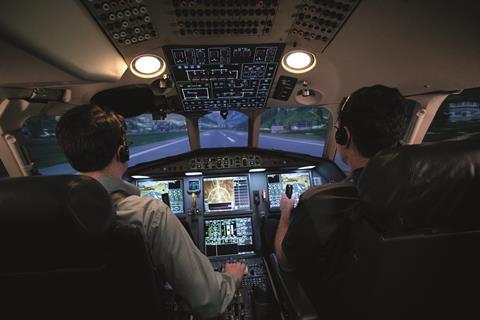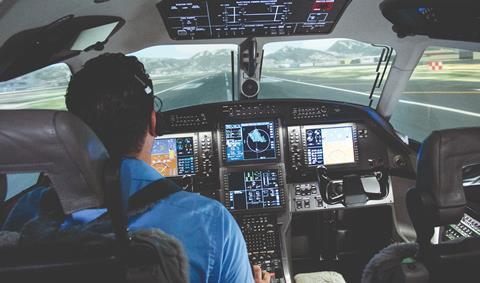During take-off, until V1 is reached, there are clearly defined decision points at which almost every pilot will abort the procedure if they have any concern with the conditions or performance of the aircraft. It is part of every pilot’s mental checklist.

The same is not always true when it comes to landing. Pilots unhappy with an approach can choose the option of a go-around. However, as Richard Meikle, executive vice-president, operations & safety at FlightSafety International, points out, the action – which typically involves executing a circuit of the airfield before repeating the landing attempt – can carry “a bit of a stigma”.
“From the very beginning, pilots are taught that good pilots land airplanes. When something isn’t quite right, the mindset is: ‘I can save it’,” says Meikle. “But these are not necessarily good behaviours. We want the default among pilots to be: ‘We are going to go around unless everything is meeting performance targets.’”
Runway excursions – defined as an aircraft departing the end or side of the runway surface, and often referred to as overruns or veer-offs – are the biggest cause of accidents in business aviation, accounting for 41% of the total number of accidents between 2017 and 2022, according to the 2022 Safety Report from independent non-profit the Flight Safety Foundation. While there may be reasons behind a runway excursion that a pilot could not reasonably have been aware of until late in the approach, they are largely due to decisions rather than manipulative skills.
This may be a result of failing to identify or interpret a risk, or continuing with a landing attempt when the better option would be to go around. The industry problem is something FlightSafety has resolved to tackle through training. Its own research in 2020 and 2021 – based on partner GE Digital’s analysis of flight operational quality assurance (FOQA) data – clearly indicated runway excursions were a major concern for business aviation operators, just as they were for airlines.
“We suspected that runway excursions were a huge cause of accidents but having that information from our work with GE was the key driver to us doing something specific in this area,” says Meikle. It led to the creation of FlightSafety’s new runway excursion prevention programme in early 2022, which has since been expanded and continues to develop. Under the partnership with GE Digital, flight data from 300 operators of more than 1,000 corporate aircraft was assessed and used by FlightSafety to tailor training programmes based on real-life operational scenarios, thus preparing pilots to identify threats that are precursors to aviation accidents and incidents. These include warning signals of a possible runway excursion.
The study also highlighted those airports at which the excursion risk was highest. One feature stood out. Seven of the top 10 runways for which there was a greater incidence or risk of runway excursions had a displaced threshold, where the threshold is set at a point other than the designated beginning of the runway and reduces the length of runway available for landings. This pointed to a need for greater vigilance when approaching such runways.
To get the message across about taking the runway excursions threat more seriously, FlightSafety set up further partnerships, including with Presage, an analytics and consultancy company that specializes in human factors in the workplace, including the cultural, interpersonal, and psychological reasons behind employee non-compliance with operational procedures. Presage had already begun an initiative with the owner flyer association Cessna Jet Pilots (CJP), called Safe to Land, which was designed to come up with standard operating procedures (SOPs) that would mitigate the risk of runway excursions by owner pilots.
With FlightSafety’s input, those Safe to Land techniques and practices are now available to CJP members. The main focus of the Safe to Land project is the establishment of new mandatory triggers for go-around decision making all the way up to touchdown. For example, many runway excursions occur following an approach that is stable up until the threshold and then becomes destabilised. Safe to Land provides visual cues and hard gates for situations such as drifting left or right of the centreline.
The results speak for themselves, as indicated by the safety record of the CJP group, which has not seen a single runway excursion since the inception of the programme.

FlightSafety, with Presage, then turned its attention to the multicrew, large-jet market with a study into the go-around decision-making habits of a sample of Gulfstream G500, G600 and G650 pilots. The choice of types was significant. Although all three are fly-by-wire, the G650’s traditional yoke is replaced with active-control sidesticks on the newer platforms meaning pilots have very different ways of flying the aircraft. The research project, the first of its kind in the two-pilot segment, was launched in mid-2022 and the publication of its findings is imminent. More than 20 pilots working for about a dozen organisations, including Gulfstream itself, were questioned about their attitudes and behaviours when it comes to go-round decision-making.
Initial findings seemed to confirm FlightSafety’s hypotheses, according to Mark Kleinhans, the company’s director, safety. “One was that pilots believe they can rescue the approach if it’s unstable. There’s an attitude of ‘It’ll be fine until it’s not’,” he says. Another was that many pilots do not recognize when the aircraft is unstable. One of the actions that FlightSafety has begun to introduce into its Gulfstream training is a clear limit on how far a pilot should continue with an unstable approach before deciding to go around. Although current guidance suggests a limit of 1,000ft, the feedback from the working group of pilots suggested that 200ft might be more appropriate as a cut-off. Modern aircraft come with features that act as an insurance policy against judgement errors, such as the predictive landing performance systems on Gulfstream aircraft.
“When these types of systems alert, it is important pilots respond accordingly,” says Meikle. But even with these advancements, Meikle warns against relying solely on technology to address deviations from planned performance. “Thrust reversers, for instance, are generally not included in the performance calculations, and they absorb a lot of indiscretion in technique, but if they don’t work, all of a sudden pilots may find they have eroded any extra safety margin,” he says. The key to a safe arrival is planning, executing to plan, and abandoning the approach or landing if targets are missed or conditions push the aircraft beyond acceptable tolerances.
While FlightSafety has been focusing on specific guidance for Gulfstream and Citation pilots, it has already begun to incorporate go-around decision-making into all its training programmes. “The general concept of understanding how much margin you have on a certain runway is universal, regardless of type,” says Meikle. FlightSafety’s efforts on runway excursions come amid a wider industry focus on the problem. In November, the National Business Aviation Association, which represents largely corporate flight departments, published a guide entitled Reducing Runway Excursions in Business Aviation, urging all operators to become familiar with the wealth of knowledge and data on the subject, and incorporate it into their SOPs.
FlightSafety’s message to the industry is to recognize the scope of the issue, take the risk seriously and train pilots to recognize the factors during each stage of an approach and landing that can lead to a runway excursion. Says Meikle: “What we are really trying to drive home is that it is unrealistic to attempt to land on a runway using book numbers if you are not using the same procedures the test pilots used to derive the numbers, and even if the best of approaches was flown, there are occasions where a go-around is necessary after the aircraft has crossed the threshold.”












































